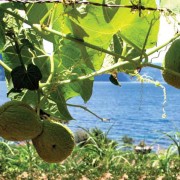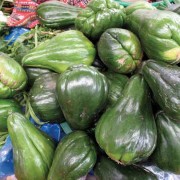This common food is found in a lot of dishes served here in Guatemala. It is most like the zucchini we all use in the USA because it is bland and therefore takes on the flavor of any spices you choose to use and is mostly healthful. For a diabetic it is a starch so portion sizes have to be watched.
Check out the quote on the bottom, ladies.

What looks like an avocado, grows on a vine, and tastes like a potato?

A few of the several varieties of güisquil; used in many of the same ways that the potato is, though it is more tender and has a slightly nutty flavor.

The tender and delicately spiraled tips of the vine are also harvested to be added to soups and stews. Here they are known as “punta de güisquil.”
text, photos and recipe by Victoria Stone
By Revue Magazine • September 1, 2009One of my favorite güisquil dishes is the Mayan omelette because of its similarity to a Spanish omeletteGüisquil (pronounced “weeskeel”) is one of the most common vegetables throughout Mexico, Central America and parts of South America. It has been famously described as a vegetable that looks like an avocado and tastes like a potato. Guisquil is also known as “chayote,” “vegetable pears” and “christophine.
Güisquil is one of the vegetables most used in all of Central America in soups and stews. It’s a pretty sure bet that if you’ve ever eaten a soup or stew in Guatemala, you’ve eaten güisquil. Like the potato, güisquil is a great addition to soups and stews because it serves as a thickening agent. It is even used in industrial food production to thicken fruit juices and baby food. Güisquil can be prepared in any way suitable for summer squash and can also be halved, stuffed and baked like acorn squash.
Not only is güisquil easy to grow, abundant and easy to transport, it’s also valued for its protein content and is purported to have anti-inflammatory and cell-regenerative properties. It is also a good source of niacin, vitamin B6, pantothenic acid, magnesium and potassium, amino acids and a very good source of dietary fiber, vitamin C, vitamin K, folate, zinc, copper and manganese.While the “fruit” of the güisquil is the part most commonly eaten, you can be sure that the ladies in the kitchen who made that stew have also been savoring the seed, which is flat and cream colored and a delicious delicacy when cooked. In Guatemalan households these are special treats saved for children. The fruit can also be eaten raw; though this is uncommon in Guatemala, in some countries it is used in salads. Even the starchy tuberous parts of the root are also edible, but are more often fed to livestock.The tender and delicately spiraled tips of the vine are also harvested to be added to soups and stews; they are a delicious addition to sautéed vegetable dishes. Here they are known as “punta de güisquil” and can be found in local markets only in the seasons when güisquil is in its early growth spurts., using güisquil in place of potatoes.Mayan Omelette
(one serving—multiply per serving)
1 medium-size güisquil
1-2 eggs
1-2 tablespoons flour
1-2 tablespoons chopped onionsPinch of salt & pepper to tasteOptional: 1-2 teaspoons. parsley or other chopped greens, 1-2 teaspoons, grated cheese
Parboil the güisquil until it can be easily pierced with a fork, 10-15 min. cooking time.Let cool, peel and cut into cubes, discarding the fiber and membrane around the seed. Scramble the eggs, add cubed güisquil, sprinkling in flour to thicken, and salt, pepper, parsley or other greens and/or cheese to taste. Now you’re ready to cook the omelette, covered, in an oiled pan on a medium flame, turning both sides until done.
¡Buen provecho!
Revue Quote
Nothing reminds a woman of all the things her husband has to do around the house like the sight of him resting.
No comments:
Post a Comment